The spirit is willing but the flesh is weak
"Can the dwarf hamster hear if I cut off his
cancerous right ear pinna?" I asked myself.
"Is there another method to remove the
fast-growing circular skin lump on the
inside of his right ear without amputating
his ear?" There was insufficient skin to
stitch up if the 0.5 cm tumour was cut off
from the ear. Besides there would be lots of
bleeding into the ear canal and the hamster
might not survive the bacterial infections.
The time-pressed young lady in her early
twenties said: "Uncle, I have been very busy
working for this company shooting
documentaries. So I have little time. In the
last 4 weeks, the ear lump grows so big."
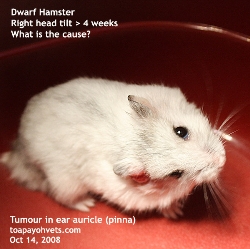 |
|
Keeps walking in circles to the right.
Head tilt in a hamster but otherwise
normal. |
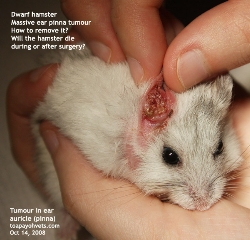 |
|
The
ear auricle has a fast growing heavy
tumour |
Skin tumours in older hamsters are
common but this one has a tumour on his ear.
Some 6 weeks ago, the young lady presented
him with a head tilt to the right but
nothing was seen in his outer ear. The
hamster did look comical to the young lady
and her best friend as the hamster kept
walking in circles with the head tilted
right. She took some pictures for me as I
trusted that she would be better at
photography, being a multi-media graduate.
She did not disappoint me as you can see her
pictures taken in August 31, 2008.
While she was dressed casual in T-shirt, her
best friend dressed like a lawyer going to
the court. However, she
and her best friend had great laughs at the
poor hamster's expense.
I admit it was funny for the average person
to see the hamster turning around in circles
to the right as the lady placed a dried worm
for the hamster to eat. The beloved hamster
was unable to get the head upright. So the
little rodent had to eat sideways. Sometimes
the hamster would be able to walk straight.
It was not practical to examine the
hamster's middle and inner ear due to its
small size and I prescribed ear medication.
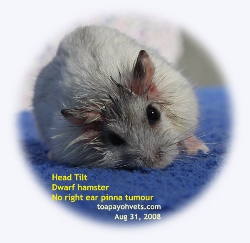 |
|
Head tilt but no ear pinna tumour
around 2 months ago |
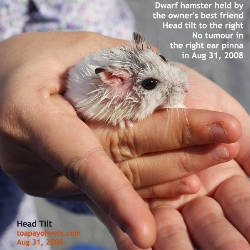 |
|
Head tilt but no ear pinna tumour
around 2 months ago |
Now, the big ear tumour had manifested on
the medial aspect of the ear as a crumbly
angry-looking tumour.
"What to do about this case?" I asked Jay
Fire, a Myanmese veterinary technician who
had some 10 years of experience in 3
small animal practices in Singapore. He was
visiting me. As he was passionate about
veterinary medicine and surgery, I took this
opportunity to discuss
with him this unusual and uncommon case of a
large tumour in the ear auricle and asked
him what to do about it. A different angle
or point of view from an experienced
Myanmese veterinarian enriches me.
"Cut off the tumour from under the ear
skin," Jay Fire proposed. It was an obvious
solution and could possibly be performed in
the dog. Dogs can be given painkillers after
the surgery and post-operation nursing can
be done easily. But this is a dwarf animal.
A dwarf hamster with the ear barely bigger
than a German Shepherd's toe.
"It is easier said than done, "I said. "The
tumour occupies more than 75% of the ear
pinna. There will be no skin to stitch up."
I said.
I explained further: "After cutting away the
tumour, there will be a very large hole.
There will be lots of bleeding after
surgery. How do you control or stop the
bleeding as it is not easy to bandage the
hamster and nurse it? The blood will go into the ear
canal and become infected. The hamster will
become sick and start rubbing his sore ear."
Jay Fire shook his head as this must be the
first time he had encountered such a case
too. Vets
can learn from each other experiences by
sharing points of views whenever possible.
It means giving away trade secrets too.
I
have no doubt that Jay Fire would make an
excellent veterinarian should he set
up his veterinary hospital in Myanmar. In
the meantime, it would be good to learn as
much as possible from each other as
veterinary medicine and surgery of various
animals sometimes need solutions that are
out of the box.
The removal of the ear auricle's tumour was
not a problem. The challenge was the
post-operation complications. The owner
naturally expects improvement rather than a
sickly hamster with a large infected and
itchy ear should the tumour be simply
removed by cutting it off.
This was one of those times the vet has to
draw his experiences from other species. As
I used to do ear cropping in dogs till it
was banned by the Veterinary Association, I
thought this problem had one solution. Ear
cropping. Or more precisely, ear amputation.
SURGICAL PROCEDURE
Gas anaesthesia. A mosquito forceps clamps
the lower end of the ear auricle below the
tumour. The scalpel cuts away the tumour.
Below the forceps, I put 2 transfixing
sutures (equivalent to a horizontal mattress
suture).
I have left the sutures longer than usual
for vets to see in the picture. There was
little bleeding when the forceps is removed.
48 hours later, the busy lady owner whom all
Singapore mothers will love to have as a
daughter-in-law as she is has a bubbling
personality, fair complexion with big-eyes
and forever a chatterbox phoned me: "When
will the stitches need to be removed?"
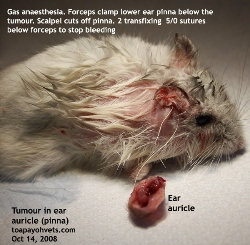 |
|
2
long transfixing sutures are
deliberately left longer than usual
for educational purposes |
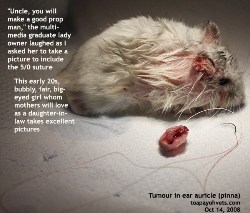 |
|
The
owner made an Elizabeth-collar out of
card herself to prevent the hamster
scratching the operation site.
|
"The
stitches will dissolve by themselves in
14-28 days. You can cut the stitch shorter
as I had left them long for photography.
Is the hamster irritated by the stitches? Is
his ear bleeding?" I asked.
"I made an Elizabeth collar out of a card
and he had to wear it," she replied. "He did
not bother with the stitches and he has no
bleeding in his operation area."
"Is his head still tilted to the right?" I
was happy to receive good news.
"Yes, yes...yes" the girl's bubbling reply
rippled over the air. "But he is much more
active now." The heavy burden in the ear had
made life miserable for this hamster. I
suspect that he would have less head tilt in
time to come if he has no tumour in his
middle or inner ear. But who knows?
It was great to know that this hamster had
no reaction. Antibiotics were given
post-operation and this lady would take time
to care for the hamster.
"How about doing some artwork for my
anti-fungal shampoo label?" I asked her as
she has experience in the graphics software
and was able to perform. This would be a
barter trade as I did not charge for the
hamster's anaesthesia and surgery as she had
just found employment and the previous
photographer employer did not pay her the
$500 salary for a long time.
"Uncle, I know your shampoo label is so
clinical. So plain and boring like all
doctor's labels. However, I work long
hours doing documentaries and advertisements
for this company. When I am free, I will do
it."
The spirit is willing but the flesh is weak.
There are so many more pleasant things to do
with her spare time. This is my common
observations of Singapore youths.
Besides, she is a very busy multi-media
graduate earning a living by working very
long hours. She earns little and has to keep
up with the high cost of living Singapore.
So I did not charge her for the recent
hamster surgery although she wanted to pay
me some money.
On my side, it is extremely difficult for me
to find a graphics designer to make my
anti-fungal shampoo label look well designed
and good to look at. I cannot find the
graphics designer and cannot afford those
working in companies.
Well, it is back to the simple plain and
boring anti-fungal shampoo label till this
girl-next-door can spare the time for me. Or
she may need to barter her graphics design
expertise for veterinary surgery another
time.
REFERENCES:
Types of hearing loss in human beings
(Calls to regulate sellers of hearing
devices
Straits times, Oct 16, 2008, Home, Page B3)
1. Conductive Hearing Loss - Blockage of
sound waves to reaching the inner ear.
2. Sensor-neural Hearing Loss - Nerve
deafness.
3. Mixed Hearing Loss - Damage to outer,
middle and inner ear.
In this hamster, it is hard to know whether
he can hear or not as it is not practical to
test him.
 TOA
PAYOH VETS
TOA
PAYOH VETS TOA
PAYOH VETS
TOA
PAYOH VETS